-
 Bitcoin
Bitcoin $109,097.4805
1.18% -
 Ethereum
Ethereum $2,619.0872
3.68% -
 Tether USDt
Tether USDt $1.0001
0.00% -
 XRP
XRP $2.3167
0.83% -
 BNB
BNB $661.5548
0.34% -
 Solana
Solana $152.1243
1.68% -
 USDC
USDC $1.0000
0.00% -
 TRON
TRON $0.2868
0.22% -
 Dogecoin
Dogecoin $0.1713
2.65% -
 Cardano
Cardano $0.5904
2.01% -
 Hyperliquid
Hyperliquid $38.7227
-0.22% -
 Sui
Sui $2.9237
2.48% -
 Bitcoin Cash
Bitcoin Cash $502.2343
2.51% -
 Chainlink
Chainlink $13.8189
3.51% -
 UNUS SED LEO
UNUS SED LEO $9.0713
0.61% -
 Stellar
Stellar $0.2577
3.55% -
 Avalanche
Avalanche $18.3973
2.90% -
 Shiba Inu
Shiba Inu $0.0...01190
3.69% -
 Toncoin
Toncoin $2.7908
0.97% -
 Hedera
Hedera $0.1615
2.27% -
 Litecoin
Litecoin $87.4295
2.44% -
 Monero
Monero $310.3402
-2.08% -
 Polkadot
Polkadot $3.4598
2.90% -
 Dai
Dai $1.0001
0.01% -
 Ethena USDe
Ethena USDe $1.0003
0.04% -
 Bitget Token
Bitget Token $4.3123
0.75% -
 Uniswap
Uniswap $7.7548
6.56% -
 Aave
Aave $292.3175
4.12% -
 Pepe
Pepe $0.0...01023
2.94% -
 Pi
Pi $0.4613
1.06%
How to prevent the address from being tampered when transferring money in Ethereum wallet?
Mar 25, 2025 at 07:00 am
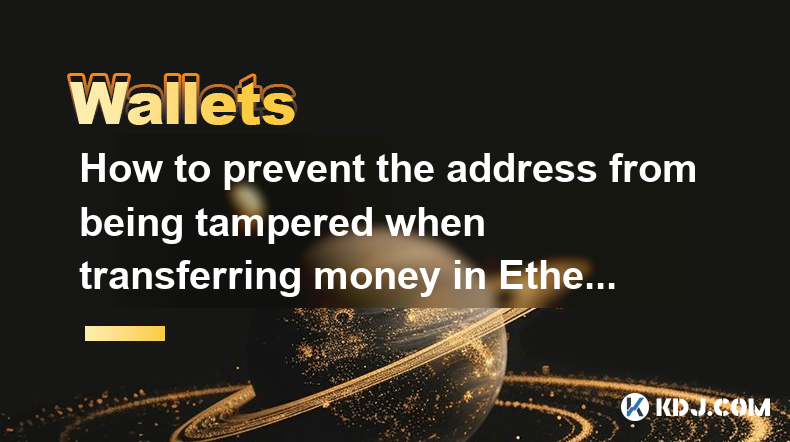
How to Prevent the Address from Being Tampered When Transferring Money in Ethereum Wallet?
Transferring funds in the Ethereum ecosystem requires meticulous attention to detail to ensure the security of your assets. A seemingly small error can lead to irreversible loss of funds. This article explores various methods to safeguard against address tampering during Ethereum transactions. Remember, vigilance is key in the world of cryptocurrency.
Understanding the Risk of Address Tampering
The primary risk lies in accidentally sending your ETH or ERC-20 tokens to an incorrect address. This could be due to manual typos, malicious actors manipulating links or QR codes, or vulnerabilities in third-party software. Once a transaction is confirmed on the Ethereum blockchain, it's irreversible. Therefore, prevention is paramount.
Verifying the Recipient Address: The Foundation of Security
- Double-check, then triple-check: Carefully compare the recipient's Ethereum address displayed in your wallet with the address you intend to send funds to. Look for any discrepancies, even a single character difference.
- Use copy-paste cautiously: Avoid manually typing the address. Instead, copy it directly from a trusted source and paste it into your wallet's send field.
- Verify checksums: Ethereum addresses incorporate checksums to detect errors. Your wallet should highlight any discrepancies in the checksum. Ensure the address you're using matches the checksum.
- Use a reputable wallet: Choose wallets with a strong reputation for security and user-friendliness, reducing the risk of vulnerabilities.
Advanced Techniques for Enhanced Security
- Paper wallets: For long-term storage, generating a paper wallet offers a high degree of security. The private key is stored offline, minimizing the risk of online attacks.
- Hardware wallets: These devices provide a secure offline environment for managing your private keys, protecting them from malware and phishing attacks. Transactions are signed on the device itself.
- Multi-signature wallets: These require multiple signatures to authorize transactions, adding an extra layer of security against unauthorized access.
Minimizing Risks with Third-Party Services
When using third-party services to interact with your Ethereum wallet, exercise caution.
- Scrutinize URLs: Be wary of phishing websites masquerading as legitimate services. Always verify the URL and look for SSL certificates.
- Check reviews and reputation: Research the platform before interacting with it. Look for reviews and check its reputation to ensure it's trustworthy.
- Avoid suspicious links: Do not click on links from untrusted sources. Malicious links can redirect you to phishing websites designed to steal your credentials.
Understanding Transaction Details Before Confirmation
Before confirming any transaction, meticulously review the details.
- Recipient Address: Verify the recipient address one last time.
- Amount: Double-check the amount of ETH or tokens you're sending.
- Gas Fee: Ensure you understand and accept the gas fee, which compensates miners for processing the transaction.
- Transaction Data (for ERC-20 tokens): Check the data field for accuracy, especially when interacting with smart contracts.
Protecting Your Wallet from Malware and Phishing
- Install reputable antivirus software: Protect your computer from malware that could compromise your wallet security.
- Beware of phishing attempts: Be cautious of unsolicited emails, messages, or phone calls requesting your private keys or wallet information.
- Use strong passwords: Create complex and unique passwords for your wallet and all online accounts.
- Regularly update your software: Keep your operating system, wallet software, and antivirus software updated to patch security vulnerabilities.
Common Questions and Answers
Q: What happens if I send ETH to the wrong address?
A: Unfortunately, transactions on the Ethereum blockchain are irreversible. Once confirmed, the funds are lost. There is no way to recover them.
Q: Can I recover funds sent to the wrong address?
A: No, there is no mechanism to reverse an Ethereum transaction. The only potential recourse might be if the recipient is cooperative and returns the funds, but this is not guaranteed.
Q: Are there any services that can help recover funds sent to the wrong address?
A: No legitimate service can recover funds sent to the wrong Ethereum address. Be wary of scams promising such services.
Q: How can I be absolutely certain I'm sending to the correct address?
A: There's no absolute certainty, but meticulous double-checking, using copy-paste instead of manual typing, verifying checksums, and using reputable wallets significantly reduces the risk.
Q: What is the best way to store my Ethereum?
A: The best method depends on your needs and risk tolerance. Hardware wallets provide the highest level of security, while software wallets offer convenience. Paper wallets are suitable for long-term offline storage.
Q: What should I do if I suspect my wallet has been compromised?
A: Immediately change your passwords, contact your wallet provider if applicable, and monitor your account for unauthorized activity. You may need to report the incident to law enforcement.
Q: Are QR codes a safe way to transfer Ethereum?
A: QR codes can be a convenient method, but only if you are absolutely certain the QR code is generated from a trusted source. Malicious actors can create fake QR codes that redirect to fraudulent websites or contain incorrect addresses. Always manually verify the address displayed in the QR code before scanning.
Haftungsausschluss:info@kdj.com
Die bereitgestellten Informationen stellen keine Handelsberatung dar. kdj.com übernimmt keine Verantwortung für Investitionen, die auf der Grundlage der in diesem Artikel bereitgestellten Informationen getätigt werden. Kryptowährungen sind sehr volatil und es wird dringend empfohlen, nach gründlicher Recherche mit Vorsicht zu investieren!
Wenn Sie glauben, dass der auf dieser Website verwendete Inhalt Ihr Urheberrecht verletzt, kontaktieren Sie uns bitte umgehend (info@kdj.com) und wir werden ihn umgehend löschen.
-
 M Jetzt handeln
M Jetzt handeln$0.2020
33.45%
-
 CRO Jetzt handeln
CRO Jetzt handeln$0.0943
16.09%
-
 SHX Jetzt handeln
SHX Jetzt handeln$0.0118
15.26%
-
 LAUNCHCOIN Jetzt handeln
LAUNCHCOIN Jetzt handeln$0.1323
14.88%
-
 VVS Jetzt handeln
VVS Jetzt handeln$0.0...02144
14.69%
-
 HSK Jetzt handeln
HSK Jetzt handeln$0.6711
13.86%
- Tether's Goldrausch: 8 Milliarden US -Dollar an Schweizer Gewölben und die Zukunft von Stablecoins
- 2025-07-09 02:50:13
- Cardano Preis: Walakkumulation weist auf die Zukunft von ADA hin?
- 2025-07-09 03:30:12
- Blockdag, Defi & Crypto Raffles: Das nächste große Ding?
- 2025-07-09 03:35:12
- Ställe, Mantel und Stablecoin -Dienstprogramm: Eine neue Ära für Kryptozahlungen?
- 2025-07-09 02:50:13
- Atom Bullish Breakout: Kryptogefühl und das Cosmos -Ökosystem
- 2025-07-09 02:55:12
- Kraken, Heckflügel und Memecoins: Eine wilde Fahrt zum Grand Prix in Singapur!
- 2025-07-09 00:50:12
Verwandtes Wissen

Was passiert, wenn ich meine Trezor -Passphrase vergesse
Jul 09,2025 at 03:15am
Verständnis der Rolle einer Trezor -Passphrase Wenn Sie eine Trezor -Hardware -Brieftasche verwenden, haben Sie möglicherweise eine Passphrase als zus...
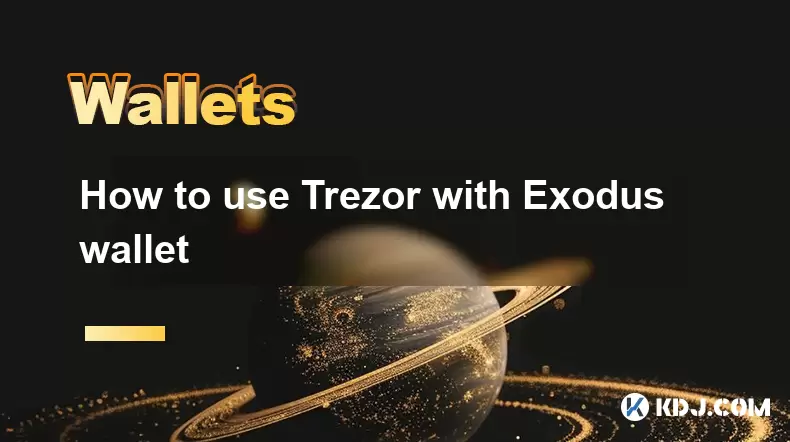
Wie man Trezor mit Exodus -Brieftasche benutzt
Jul 09,2025 at 12:49am
Verbinden Sie Trezor -Hardware -Brieftasche an Exodus -Software -Brieftasche Um Trezor mit Exodus -Brieftasche zu verwenden, müssen Benutzer die Hardw...
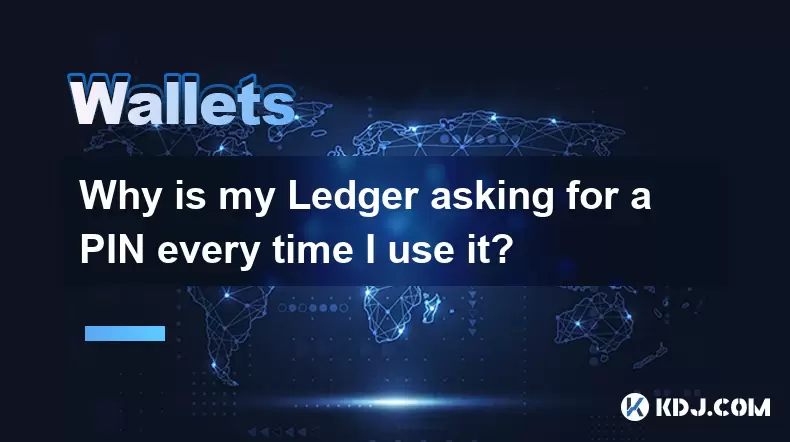
Warum fragt mein Hauptbuch jedes Mal, wenn ich es benutze, um eine PIN?
Jul 08,2025 at 11:21pm
Verständnis des Zwecks des PINs auf Ihrem Hauptbuchgerät Der PIN (Personalidentifikationsnummer) ist eine entscheidende Sicherheitsfunktion, die in je...
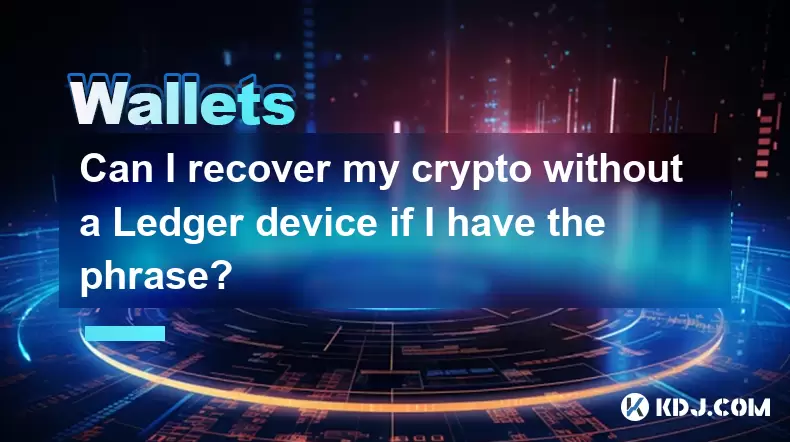
Kann ich meine Krypto ohne Ledger -Gerät wiederherstellen, wenn ich den Ausdruck habe?
Jul 09,2025 at 01:36am
Verständnis der Rolle eines Wiederherstellungsausfalls in der Kryptosicherheit Wenn Sie Ihren Wiederherstellungsausdruck haben, aber kein Ledger -Gerä...
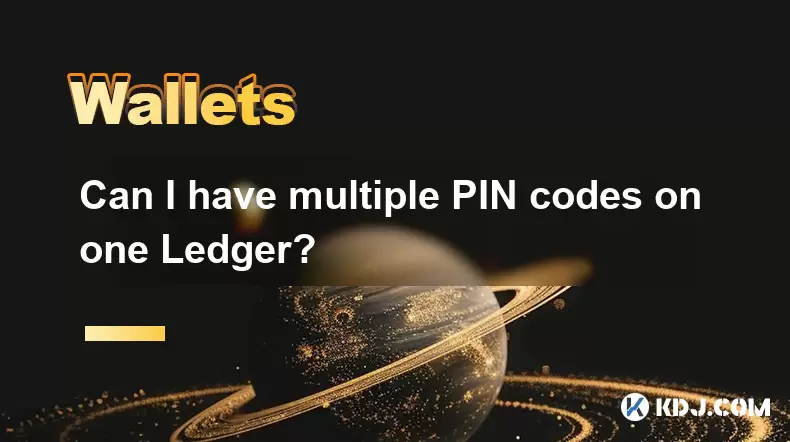
Kann ich mehrere PIN -Codes in einem Hauptbuch haben?
Jul 09,2025 at 12:35am
Verständnis der Grundlagen des dezentralen Austauschs (DEXS) Ein dezentraler Austausch oder Dex ist eine Art von Kryptowährungshandelsplattform, die o...
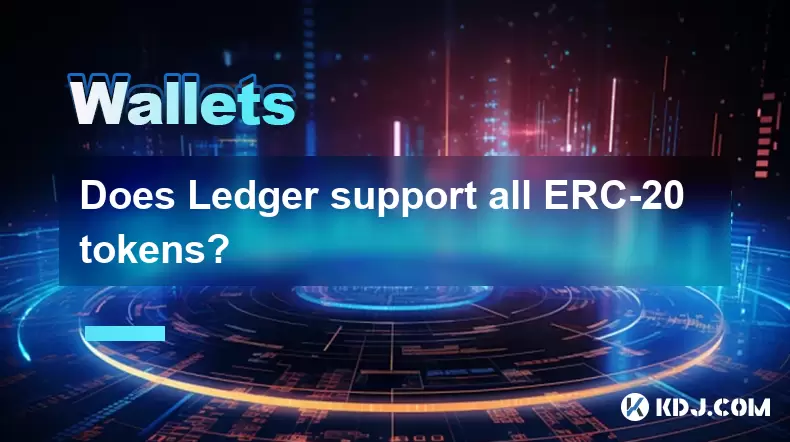
Unterstützt Ledger alle ERC-20-Token?
Jul 09,2025 at 03:42am
Ledger -Geldbörsen und ihre Token -Unterstützung verstehen Hauptbuchhöfe wie das Hauptnano und das Ledger Nano X sind Hardware -Geldbörsen, die für di...

Was passiert, wenn ich meine Trezor -Passphrase vergesse
Jul 09,2025 at 03:15am
Verständnis der Rolle einer Trezor -Passphrase Wenn Sie eine Trezor -Hardware -Brieftasche verwenden, haben Sie möglicherweise eine Passphrase als zus...

Wie man Trezor mit Exodus -Brieftasche benutzt
Jul 09,2025 at 12:49am
Verbinden Sie Trezor -Hardware -Brieftasche an Exodus -Software -Brieftasche Um Trezor mit Exodus -Brieftasche zu verwenden, müssen Benutzer die Hardw...

Warum fragt mein Hauptbuch jedes Mal, wenn ich es benutze, um eine PIN?
Jul 08,2025 at 11:21pm
Verständnis des Zwecks des PINs auf Ihrem Hauptbuchgerät Der PIN (Personalidentifikationsnummer) ist eine entscheidende Sicherheitsfunktion, die in je...

Kann ich meine Krypto ohne Ledger -Gerät wiederherstellen, wenn ich den Ausdruck habe?
Jul 09,2025 at 01:36am
Verständnis der Rolle eines Wiederherstellungsausfalls in der Kryptosicherheit Wenn Sie Ihren Wiederherstellungsausdruck haben, aber kein Ledger -Gerä...

Kann ich mehrere PIN -Codes in einem Hauptbuch haben?
Jul 09,2025 at 12:35am
Verständnis der Grundlagen des dezentralen Austauschs (DEXS) Ein dezentraler Austausch oder Dex ist eine Art von Kryptowährungshandelsplattform, die o...

Unterstützt Ledger alle ERC-20-Token?
Jul 09,2025 at 03:42am
Ledger -Geldbörsen und ihre Token -Unterstützung verstehen Hauptbuchhöfe wie das Hauptnano und das Ledger Nano X sind Hardware -Geldbörsen, die für di...
Alle Artikel ansehen

























































































